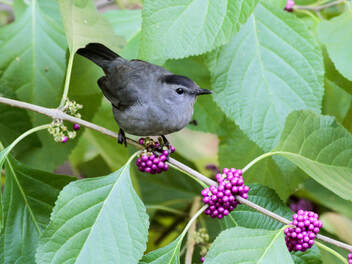 Gray Catbird on American beautyberry. Photo by Will Stuart. Gray Catbird on American beautyberry. Photo by Will Stuart. By Steve Phenicie People hearing the Gray Catbird for the first time have been known to exclaim incredulously, “A bird made that sound?” Yes, it did – this common, widespread bird is well-known for making a mewing sound like that of a cat. It also mimics the calls of other birds as well as tree frogs and mechanical sounds. Because of its well-developed vocal organ, it even has the ability to make two different sounds at once. The catbird is mostly gray, of course, but its coloration has some touches that might play well with a Madison Avenue ad executive. The long tail is dark gray to black, and the bird has black eyes, legs, bill and “cap.” Best of all, look for the chestnut-colored feathers under the tail. In size the catbird is slightly smaller than a Northern Mockingbird. Although catbirds sometimes appear in the open, they like to hide in thickets, brambles, and shrubby or brushy areas, particularly near water, including the Chattahoochee River. Their triangular-shaped range map stretches from Nova Scotia to British Columbia to Panama, with the winter range generally being limited to the Atlantic seaboard. A few linger far to the north, however, if they can find food. Catbirds apparently migrate mostly at night. Birds breeding in the Northwest seem to migrate east before turning south in fall, since they are rarely seen in the Southwest. In the winter the bird is rare north of Georgia’s Fall Line. At least in the East, populations seem to have been growing in recent decades. In breeding season, a nest is built mostly by the female in dense shrubs, thickets, briar tangles, or low trees, usually three to 10 feet above the ground. The structure is a large, bulky cup of twigs, weeds, grass, leaves, and sometimes pieces of trash, lined with rootlets and other fine materials. Mama catbird usually lays four greenish blue eggs, although there can be from two to six. Incubation is by the female only and lasts about 12 or 13 days. Both parents feed the nestlings. Young leave the nest about 10 or 11 days after hatching. There are two broods per year. Catbirds won’t take any bullying from Brown-headed Cowbirds: If a cowbird lays eggs in the nest of a catbird, the adult catbirds usually puncture and eject them. The catbird’s diet is heavy on insects and berries. Especially in early summer, it consumes many beetles, ants, caterpillars, grasshoppers, crickets, and other insects, as well as spiders and millipedes. Nestlings are fed almost entirely on insects. In fall and winter it eats many kinds of wild berries and some cultivated fruit. On rare occasions it catches small fish. At feeders, catbirds have been known to eat doughnuts, cheese, boiled potato, and corn flakes. Native fruit-bearing trees and shrubs such as dogwood, winterberry, and serviceberry might attract them to your yard. The phrase “in the catbird seat” means being in a position of advantage and is based on the fact that the bird likes to make its mocking calls from a secluded perch. The term is rooted in the South and was popularized by the sportscaster Red Barber, who called Major League Baseball games from the 1930s through the 1960s and titled his autobiography Rhubarb in the Catbird Seat.
2 Comments
Evan Torch
5/23/2023 02:11:58 am
Hello,
Reply
Georgia Audubon
5/23/2023 08:05:27 am
From your description of the coloration and sound, it sounds like an Eastern Bluebird attacking your window. A Gray Catbird would have a clearly visible black cap and a rusty color under the tail. That clacking noise is also typical of bluebirds. Attacking their reflection in the window, either home or car, is very typical this time of year. The behavior will subside once nesting season ends.
Reply
Your comment will be posted after it is approved.
Leave a Reply. |
AuthorBirds Georgia is building places where birds and people thrive. Archives
April 2024
Categories |

 RSS Feed
RSS Feed

